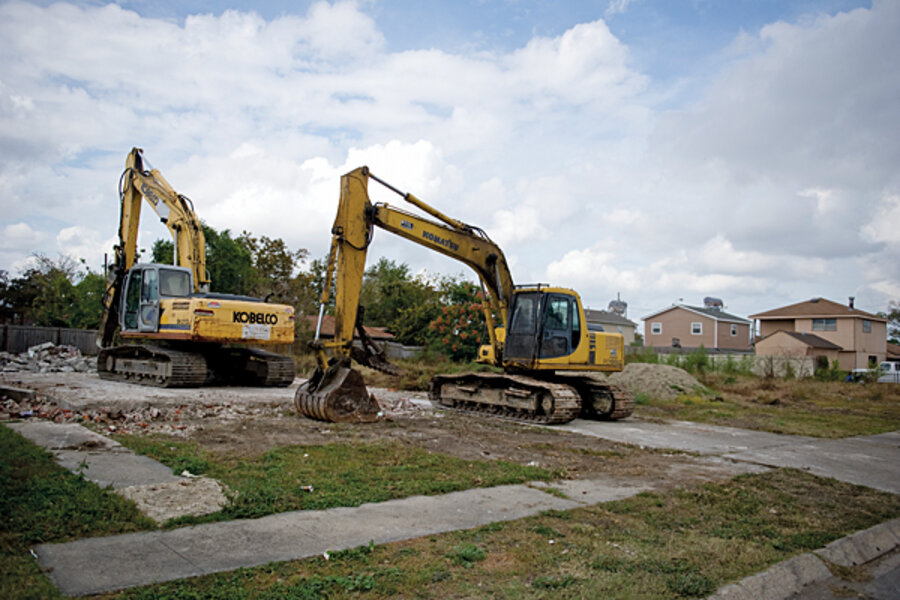New Orleans' razing craze aims to clear way for post-Katrina recovery
Loading...
| New Orleans
What hurricane Katrina started nearly seven years ago, the city of New Orleans itself is now in the unenviable position of finishing.
Mayor Mitch Landrieu has made razing and cleaning up 40,000 abandoned homes and properties – the biggest such inventory in the nation, besting Detroit – a cornerstone of his administration. His aim: to piece back together the racial and social mosaic that for centuries defined the gritty, buoyant city along the Mississippi River's crescent bend.
The 2010 Census, conducted five years after Katrina, found that 25 percent of New Orleans residential addresses were vacant, and Mr. Landrieu's administration is now moving aggressively to tear down homes that are abandoned or deemed uninhabitable. Last year the city razed 1,589 decrepit buildings, up from 154 two years earlier, in an attempt to clear the way for redevelopment in neighborhoods previously filled (and still partially filled) with poor and minority residents.
So far, Landrieu, who took office in May 2010, is getting an 'A' for effort. Aside from demolitions, the city subsidized construction of 1,038 new homes and 168 renovations in 2011. New Orleans, on the whole, saw home prices rise 11 percent last year.
But the mayor's goal of redeveloping 10,000 blighted properties by the end of 2013 won't be easy to achieve. Financial and political hurdles are substantial, never mind Louisiana's unique adherence to the property rules of the Napoleonic Code, where the concept of "forced heirship," or guaranteed property rights of descendants, can create a Gordian knot of paperwork for lawyers to untangle.
After clearing so many lots, what does the city hope to do with them? In short, officials intend to sell the cleared lots to developers through auctions, or use federal grants to give private and nonprofit developers incentive to build homes and apartments for low- and moderate-income residents.
"They're trying to find whatever means possible, including incentives, to maximize [available land] to create viable communities," says Rob Olshansky, a University of Illinois planning professor who has studied post-Katrina re-building. "But there are still two questions that remain: What happens to all those people who thought they wanted to rebuild but didn't because their neighbors weren't coming back? And, two, if the city ends up obtaining the most undesirable properties in the city, are they going to end up just holding a bunch of stuff that's going to cost money to maintain?"
Five years ago, residents helped create a blueprint for rebuilding New Orleans known as the Unified Plan. It backed resettlement of hard-hit areas in poor, low-lying districts, partly in a bid to retain a diverse populace. But New Orleans is today in danger of becoming what residents expressly said they didn't want: a smaller, whiter, more upscale city. Beyond the edges of the French Quarter and the tony Garden District, weedy wastelands dominate fabled neighborhoods such as the Lower Ninth Ward, Pontilly, and Lakeview, and in some spots packs of pitbulls roam, squatters languish, and the odd boat lies overturned.
"Families should come home, but you can't come home to something that's not there," says Perrie Duplessis, an aspiring carpenter working on a home in the Upper Ninth Ward.
While most agree that the sheer scope of blight is retarding the city's recovery, not everyone sees the bulldozer as the answer.
"The fact that New Orleans still has so many intact historic neighborhoods is a testament to the fact that we haven't had much good government, that we're not terribly efficient at tearing things down, and that there are huge proponents of preservation who say, 'Whoa, let's not just go crazy and tear everything down,' " says architecture historian Jane Brooks, chairwoman of urban planning at the University of New Orleans. "But you do have this particular problem since Katrina, where people are trying to rebuild next door to an abandoned property with weeds waist-high and rats, and it's not conducive for those putting sweat and money" into redevelopment.
But weeds and decrepit homes are not the main challenge for city planners, some experts argue. Rather, it's that the old social order has exploded, leaving a Katrina diaspora that is reluctant to return to darkened streets where commerce, social scenes, and property values have yet to revive.
"In the Ninth Ward especially, we're talking about a total collapse of a market, where all different aspects – socioeconomic, demographic, infrastructure, business – every system, including the social system, collapsed" as a result of Katrina, says Michelle Thompson, a demographer at the University of New Orleans. "It's a system that needed to be rebuilt, and all of it was not done in a comprehensive way. The unified planning process ... was great, but the implementation has not happened."
In the Lower Ninth Ward, empty lots now outnumber those with houses on them, according to a University of New Orleans website that tracks property data, and Professor Olshansky expects that some of that vacant land eventually will be reconfigured into parks.
To pursue his blight fight, Landrieu has stepped up code enforcement and increased tax lien foreclosures. Moreover, last month one of his top insiders, "blight czar" Jeff Hebert, a planner trained at the Massachusetts Institute of Technology, was appointed to lead the state-chartered New Orleans Redevelopment Authority – a sign that two entities that have butted heads in the past will be working more collaboratively. In another dramatic move, the city is taking possession of 3,600 properties handed over to the state as part of the Road Home recovery program.
As street resurfacing projects pick up, new schools and playgrounds open, and visible progress is made to eradicate blight, a sense of momentum is building in the Big Easy, city officials insist.
"Everybody has been waiting for this kind of work in New Orleans, and I think you're going to see great success," says Mr. Hebert.
Staff photographer Ann Hermes contributed reporting for this story.








